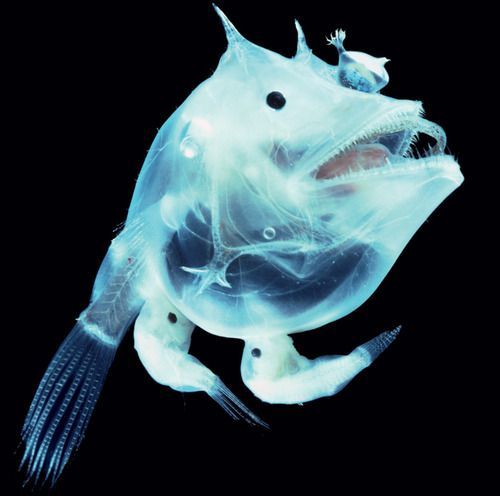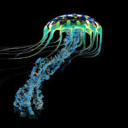Deep-sea White Anglerfish


Deep-sea white anglerfish
Haplophryne mollis
The Deep-sea white anglerfish is a ghostly white creature found at depths between 1000m to 4000m. The strange bulge between its eyes is a bioluminescent lure. The main fish above is a female and the tiny fish attached to her body are males. Since it is difficult to find mates in the deep ocean, male fish latch onto the female with hooked teeth. Even though the male fish are parasitic, they are eventually reduced to pockets of sperm that are used for reproduction. For all you fellas out there that have a rough time with the ladies, be thankful that you are at least not a bag of gonads floating through the ocean.
Photo credit: https://www.pinterest.co.uk/pin/440297301041956897/
https://news.cgtn.com/news/3d3d414d3559444f7a457a6333566d54/share_p.html
More Posts from Bioluminescentoceangoddess and Others


Sea elephant
Carinaria japonica
The Sea Elephant is a translucent sea snail that has a large muscular body and a tiny triangular shell. Its foot is used for crawling on the ground, and it can be transformed into a fin that is used for swimming. It is called the “sea elephant” because it has a small trunk in its mouth that is used to swallow prey. Furthermore, the Sea Elephant eats arrow worms and jellies.
Photo credit
https://bodegahead.blogspot.com/2014/12/carinaria-part-2.html
http://tolweb.org/Carinaria_japonica/28750


Pigbutt worm
Chaetopterus pugaporcinus
The Pigbutt worm or the flying buttocks of the sea is spotted floating between 965 m to 1300 m in the deep ocean. It is actually a polychaete (polly-keet) worm species that burrows in the ground as an adult, and floats around the ocean as a baby. The worm feeds itself : by creating a balloon of mucus; collecting particles on the mucus; and then consuming the particles. It is the rarest and thickest worm in the deep ocean, for only ten have been spotted.
Photocredit: https://roaring.earth/pigbutt-worm/

Squarenose Helmetfish
Scopelogadus beanii
The Squarenose Helmetfish is found between 800m to 4000m in the ocean. It received this unique name due to its scales reminding scientists of an armored helmet worn by medieval knights. It also has unusual holes around its face, and the white strands covering its face are sensory canals.
Photo credit: https://www.vistaalmar.es/especies-marinas/peces-extranos/449-que-peces-mas-extranos.html


Cockatoo Squid
Galiteuthis phyllura
The Cockatoo squid is a highly-specialized oddity of the deep ocean and found at depths between 300 to 1400 m. It is completely transparent, except for its eyes. It also has bioluminescent photophores that are directed downward: this makes it difficult for deep sea predators to see the Cockatoo Squid. It was named after the Cockatoo because it holds its tentacles above its head, resembling the bird. The Cockatoo squid can also get fairly large with adults reaching lengths of 2.7 meters (over 6 ft.)
Photocredit: https://www.americanscientist.org/article/at-home-in-the-dark
https://www.pinterest.com/pin/28710516347382519/



Black Dragonfish
Idiacanthus atlanticus
The Black Dragonfish are needle-like fish that migrate between 500m and 2000m in the deep ocean. Females are black with 6 stripes and lack a barbel, pelvic fins, and sharp teeth. Males, on the other hand, are dark brown and have a barbel, which is the light producing structure on its chin. Furthermore, it uses bioluminescence to detect prey instead of lure prey.
Photo credit: https://scitechdaily.com/scientists-learn-secrets-from-ultra-black-skin-that-allows-deep-sea-fish-to-lurk-unseen/
https://steemit.com/life/@munnashah/the-most-terrible-and-surprising-7-animals-of-the-sea
https://knowyourmeme.com/photos/995601-thalassophobia


Piglet Squid
Helicocranchia pfefferi
The Piglet Squid is a very small and delicate, transparent squid. It is found at depths between 400 to 1000 m. It has an unique siphon that is used for jet propulsion and it resembles a pig muzzle. The young piglet squids tend to live close to the surface, and steadily migrates downward as they grow. This behavior is called ontogenetic migration.
Photo credit: http://photo.cctv.com/2019/07/23/PHOAKMEBh8xJRaHXEUIGx8kE190723.xml
https://www.ourbreathingplanet.com/banded-piglet-squid/


Blacksnout Seasnail
Paralipparis copei copei
The Blacksnout Seasnail may not look like a snail, but it does have a slimy, gelatinous substance that covers its body. It can be found at depths between 200 m to 1692 m, and adults grow up to be 17 cm in size (approximately 6.5 in). It also has an elongated body that resembles an eel. Furthermore, it can be seen rolling itself in a loop; this behavior is a defensive posture that makes it appear like a jelly. In the darkness, predators tend to avoid the Blacksnout Seasnail because its often mistaken as a hunter due to its appearance and behavior.

Threadfin Snailfish
Careproctus longifilis
The Threadfin Snailfish resembles a prehistoric tadpole that is ghostly white. The holes in its face are large sensory pores that help them detect changes in the ocean. It is often found at depths between 1900 to 2997 meters.
Photo credit: https://www.timeout.com/singapore/museums/creatures-of-the-deep
Sea sparkle is a common, bioluminescent plankton. Even though its not an animal, it is worth sharing.


Sea sparkle
Noctiluca scintillans
Sea sparkle is a bioluminescent dinoflagellate that blooms in many coastal waters. Sea sparkle feeds on plankton, diatoms, fish eggs, and other dinoflagellates. It also has a flagellum, or tiny tail, that helps it move around in the water. Even though sea sparkle is beautiful to witness at night, it is hazardous to other marine species and resembles a reddish-pink film during the day.
Photo credit:
https://alexandrathemb.tumblr.com/post/49814932878/noctilucas-scintillans-a-bioluminescent
https://thevelv.blogspot.com/2015/07/noctiluca-scintillans.html


Pacific Viperfish
Chauliodus macouni
The Pacific Viperfish looks intimidating with its sharp, pointy teeth and large jaws. However, its body is small and elongated. It can be found at depths ranging from 250m to 4390m. The Pacific Viperfish long teeth are an unique adaptation designed to keep prey trapped, but it is dangerously close to its eyes. There have been instances when they have caught prey that are too large to swallow and it dies along with its last meal. The Pacific Viper also has photophores along its body and a light organ near its dorsal fin. These organs exhibit bioluminescence and help with attracting pray: as well as, communicating with mates and confuse predators. It is one of the most ferocious predators of the deep ocean.
Photo credit: https://www.science-rumors.com/top-20-pacific-viperfish-facts-to-know-what-this-creature-is/
https://goldfisho.com/everything-you-need-to-know-about-viperfish/
-
 stardustandmoonflowers liked this · 1 year ago
stardustandmoonflowers liked this · 1 year ago -
 lemon-lime-lauren reblogged this · 1 year ago
lemon-lime-lauren reblogged this · 1 year ago -
 dragoonmagic liked this · 1 year ago
dragoonmagic liked this · 1 year ago -
 bewrabawa reblogged this · 1 year ago
bewrabawa reblogged this · 1 year ago -
 a-lilacsong liked this · 2 years ago
a-lilacsong liked this · 2 years ago -
 thevoiceofmadness liked this · 2 years ago
thevoiceofmadness liked this · 2 years ago -
 waynehouses liked this · 2 years ago
waynehouses liked this · 2 years ago -
 hauntedcandlemaker liked this · 2 years ago
hauntedcandlemaker liked this · 2 years ago -
 a-random-brick liked this · 2 years ago
a-random-brick liked this · 2 years ago -
 what-theactualfuck liked this · 2 years ago
what-theactualfuck liked this · 2 years ago -
 deansboots liked this · 2 years ago
deansboots liked this · 2 years ago -
 spooky-alien liked this · 2 years ago
spooky-alien liked this · 2 years ago -
 jabberwockus liked this · 2 years ago
jabberwockus liked this · 2 years ago -
 ancientsharkbones liked this · 2 years ago
ancientsharkbones liked this · 2 years ago -
 chtuloctopis liked this · 2 years ago
chtuloctopis liked this · 2 years ago -
 couldhavechoosensthbetter liked this · 2 years ago
couldhavechoosensthbetter liked this · 2 years ago -
 nightmaresandwich liked this · 2 years ago
nightmaresandwich liked this · 2 years ago -
 rsfz-rennane liked this · 2 years ago
rsfz-rennane liked this · 2 years ago -
 hec34 liked this · 2 years ago
hec34 liked this · 2 years ago -
 kai-atlantis liked this · 2 years ago
kai-atlantis liked this · 2 years ago -
 mellowstrangereagle reblogged this · 2 years ago
mellowstrangereagle reblogged this · 2 years ago -
 mellowstrangereagle liked this · 2 years ago
mellowstrangereagle liked this · 2 years ago -
 airmanisr reblogged this · 2 years ago
airmanisr reblogged this · 2 years ago -
 airmanisr liked this · 2 years ago
airmanisr liked this · 2 years ago -
 moondazie liked this · 2 years ago
moondazie liked this · 2 years ago -
 austinsreal liked this · 2 years ago
austinsreal liked this · 2 years ago -
 buggoogly reblogged this · 2 years ago
buggoogly reblogged this · 2 years ago -
 bluelagoonn reblogged this · 2 years ago
bluelagoonn reblogged this · 2 years ago -
 emotionalmoonbot liked this · 2 years ago
emotionalmoonbot liked this · 2 years ago -
 technicallypalewombat reblogged this · 2 years ago
technicallypalewombat reblogged this · 2 years ago -
 general-robert-e-lee reblogged this · 2 years ago
general-robert-e-lee reblogged this · 2 years ago -
 saltmatchescandlewax reblogged this · 2 years ago
saltmatchescandlewax reblogged this · 2 years ago -
 iamapan242 liked this · 2 years ago
iamapan242 liked this · 2 years ago -
 kimberlylovesart liked this · 2 years ago
kimberlylovesart liked this · 2 years ago -
 justsomefandomnerd liked this · 2 years ago
justsomefandomnerd liked this · 2 years ago -
 starstruck-shadow reblogged this · 2 years ago
starstruck-shadow reblogged this · 2 years ago -
 luckyicekitsune liked this · 2 years ago
luckyicekitsune liked this · 2 years ago -
 klugpuuo liked this · 2 years ago
klugpuuo liked this · 2 years ago -
 vampiremasochist liked this · 2 years ago
vampiremasochist liked this · 2 years ago -
 whisperingzeltus reblogged this · 2 years ago
whisperingzeltus reblogged this · 2 years ago -
 g0reoz reblogged this · 2 years ago
g0reoz reblogged this · 2 years ago -
 g0reoz liked this · 2 years ago
g0reoz liked this · 2 years ago -
 osmiumtrash liked this · 2 years ago
osmiumtrash liked this · 2 years ago -
 crystalkleure reblogged this · 2 years ago
crystalkleure reblogged this · 2 years ago -
 cladlless-colletc reblogged this · 2 years ago
cladlless-colletc reblogged this · 2 years ago

Bioluminescence is a chemical reaction that produces light. Many deep sea animals use bioluminescence. This blog is dedicated to educating the public about the amazing creatures that thrive in the deep sea.
57 posts